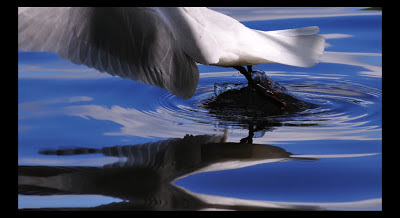But still, each to their own. Here are some points to consider in order to get the best of this experience.
1. Understand what you're after and tune your camera accordingly
BIF photos are a very special kind of photography and you cannot hope to have any remote chance at succeeding without having clear goals. What kind of birds will you be photographing? Will they be flying, landing, or taking off? Or all of the above? Know the birds' habits. A magpie jumping clumsily couple of steps before slowly flapping away is a much different thing than a seagull jumping out of water in a split second. If you want to freeze action, you will need 1/1250 or faster.
2. Light, light, light
You will need a lot of light. Which means, you will need plenty of sunlight in a well-lit area. If your idea was to get BIF photos in dawn/dusk, pretty much forget it. Unless if you can get your hands on a 300mm f/2.8 and a camera with good high ISO performance (and plenty of patience, and a well-polished technique). Start modestly, opt for plenty of light.
3. Depth of field is your friend
With a shutter speed of 1/1250 and plenty of light, you can get (even with raising the ISO a bit) an aperture of f/11 or so. Use it. Even the best camera/lens system cannot possibly cope with the extremely rapid movements of a bird. At 300mm and f/5.6, the depth of field is too short to cope with many situations and you will be frustrated. Close down to f/11 and increase the depth of field to have more latitude.
 |
| Anticipation is the key to a successful photo |
This is an art and it comes with experience but it's absolutely necessary. If you have spent enough time with the birds, you will learn to understand their habits and anticipate their movements. You will learn when they're probably about to fly away, when they're probable to pick up a fight, and so on. Anticipating action is far more important than fps performance or AF speed.
5. Post-Production
This is something that might feel unrelated - or at the very least something not specifically connected with BIF photos - but there is an important element. Taking photos in daylight, could mean that there is either too great a contrast or blocked shadows/clipped highlights. There is also a chance the White Balance (if you used Auto) will be off - the reason being that a camera's Auto White Balance might be fooled by excessive greenery (whether directly or e.g. reflected off water). A so-so image on camera might look far more attractive once you spend some time with it in post-production.
 |
| Be creative with your compositions. Not all bird photos have to look the same |
Bonus Thoughts: What camera and lens do I need for birds in flight photos?
The best (in fact the only) answer is: what you have/can afford. Technique is far, far more important. An experienced photographer can get far better photos using a D70 and an AF-S 55-200 than a novice using a D3 and a 70-200 f/2.8
Since you'll be taking photos in daylight, you don't need a fast aperture anyway (not to mention, you should polish your technique using small aperture, like I told you). Start with "easily accessible" birds - e.g. ducks or gulls. For that, a 55-200 or 70-300 type zoom is fine.
As for camera, it makes no difference really. Ideally, a D300 with 6-8 fps and superior AF is of course better (provided you know how to get the best of it!), but honestly, even a basic entry level will be fine, especially if you learn how to anticipate. If you learn that, you don't need 6-8 fps. You need one shot and that's it.

No comments:
Post a Comment